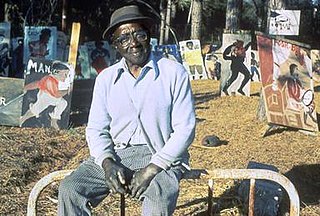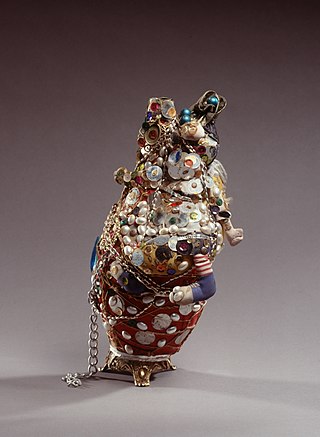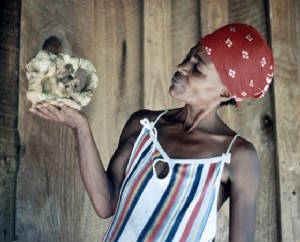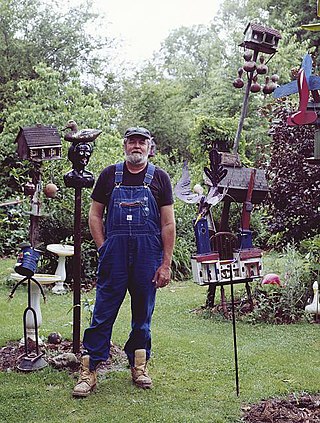
The art world comprises everyone involved in producing, commissioning, presenting, preserving, promoting, chronicling, criticizing, buying and selling fine art. It is recognized that there are many art worlds, defined either by location or alternative definitions of fine art. Some may use the singular art world to refer only to the elite level of globalized fine art. The art world(s) are continually changing in response both to the creativity of those that create art and in response to social change.

Folk art covers all forms of visual art made in the context of folk culture. Definitions vary, but generally the objects have practical utility of some kind, rather than being exclusively decorative. The makers of folk art are typically trained within a popular tradition, rather than in the fine art tradition of the culture. There is often overlap, or contested ground with 'naive art'. "Folk art" is not used in regard to traditional societies where ethnographic art continue to be made.
Helen Burkhart Mayfield (1939–1997) was an American artist from Texas.

Thomas "Sam" Doyle (1906–1985) was an African-American artist from Saint Helena Island, South Carolina. His colorful paintings on sheet metal and wood recorded the history and people of St. Helena's Gullah community.

Paquet congo are Haitian spiritual objects made by vodou priests and priestesses during ceremonies. Their name comes from the ancient Kongo Kingdom in Africa, where similar objects called nikisi wambi are found.
Ruth B. Bottigheimer is a literary scholar, folklorist, and author. Currently Research Professor in the Department of English at Stony Brook University, State University of New York she specializes in European fairy tales and British children’s literature. She has also rersearched and published on the history of illustration, the religious socialization of children through edited Bible narratives, and stories told by Hannā Diyāb to Antoine Galland and included in his French edition of the Arabian Nights. She “has been hailed as one of America’s foremost Grimm scholars”.
Kent Ryden is a Professor of American and New England Studies at the University of Southern Maine. He is known for writing and teaching in the fields of regional literature, cultural geography, folklore and environmental humanities.
James P. Leary is a folklorist and scholar of Scandinavian studies, and a professor at the University of Wisconsin–Madison.
Mario Sanchez was a Cuban-American folk artist from the Key West cigar-making neighborhood known as "Gato's Village". Self-taught, Sanchez began working artistically in 1930 on media like paper bags and cedar wood boards. He would come to specialize in bas relief wood carvings that he would then paint over in vibrant colors, usually depicting scenes of everyday Key West life. Some of his carvings have been valued at more than $50,000.
Nadjeschda Overgaard was an American needleworker who received a National Heritage Fellowship from the National Endowment of the Arts for her lifetime of work in 1998.

Juanita Rogers was a self-taught American folk artist. She was born in Tintop, Alabama to Thomas and Sally Rogers, although she claimed she was adopted after arriving in North Montgomery by carnival train at the age of five. Her mother was part Creek Indian, and died when Juanita was about twenty. Juanita attended a Catholic mission school. She was married to Sol Huffman, who died in 1980.
María Martínez-Cañas is a Cuban-born photographer whose work primarily deals with her Cuban heritage and journeys of discovery.
Theresa Secord is an artist, basketmaker, geologist and activist from Maine. She is a member of the Penobscot nation, and the great-granddaughter of the well-known weaver Philomene Saulis Nelson. She co-founded, and was the director of, the Maine Indian Basketmakers Alliance (MIBA) in Old Town, Maine.

Binford Taylor Carter, Jr., known as Benny Carter or Bennie Carter, was an American contemporary visual artist. His primary focus was as a painter and sculptor within the genres of folk art and outsider art.

Betty Manygoats is a Navajo artist known for her ceramic work. She lives and works at Cow Springs on the Navajo Nation in Arizona in the American Southwest.
Lucinda Toomer was an American artist who worked in the African-American tradition of quiltmaking. Her quilts are known for their bold compositions, visual rhythm, and improvisational style. They were at the forefront of a surge of national recognition for the art form during the 1990s.
Frank Edward Romero is an American artist considered to be a pioneer in the Chicano art movement. Romero's paintings and mural works explore Chicano and Los Angeles iconography, often featuring palm trees and bright colors.
Anna "Anta" Birgitta Rooth was the first Swedish professor of ethnology at Uppsala University. She is known for her research into folklore, especially the Cinderella story.
Belle Young Gochenauer Deacon was an American basketmaker and language and folklore expert. As an Alaska Native elder, she held and shared knowledge of the language and traditions of the Athabascan people. She received the National Heritage Fellowship in 1992.
Alyne Harris is an African American painter from Gainesville, Florida. She is a self taught artist who draws inspiration from her surroundings and religion.






